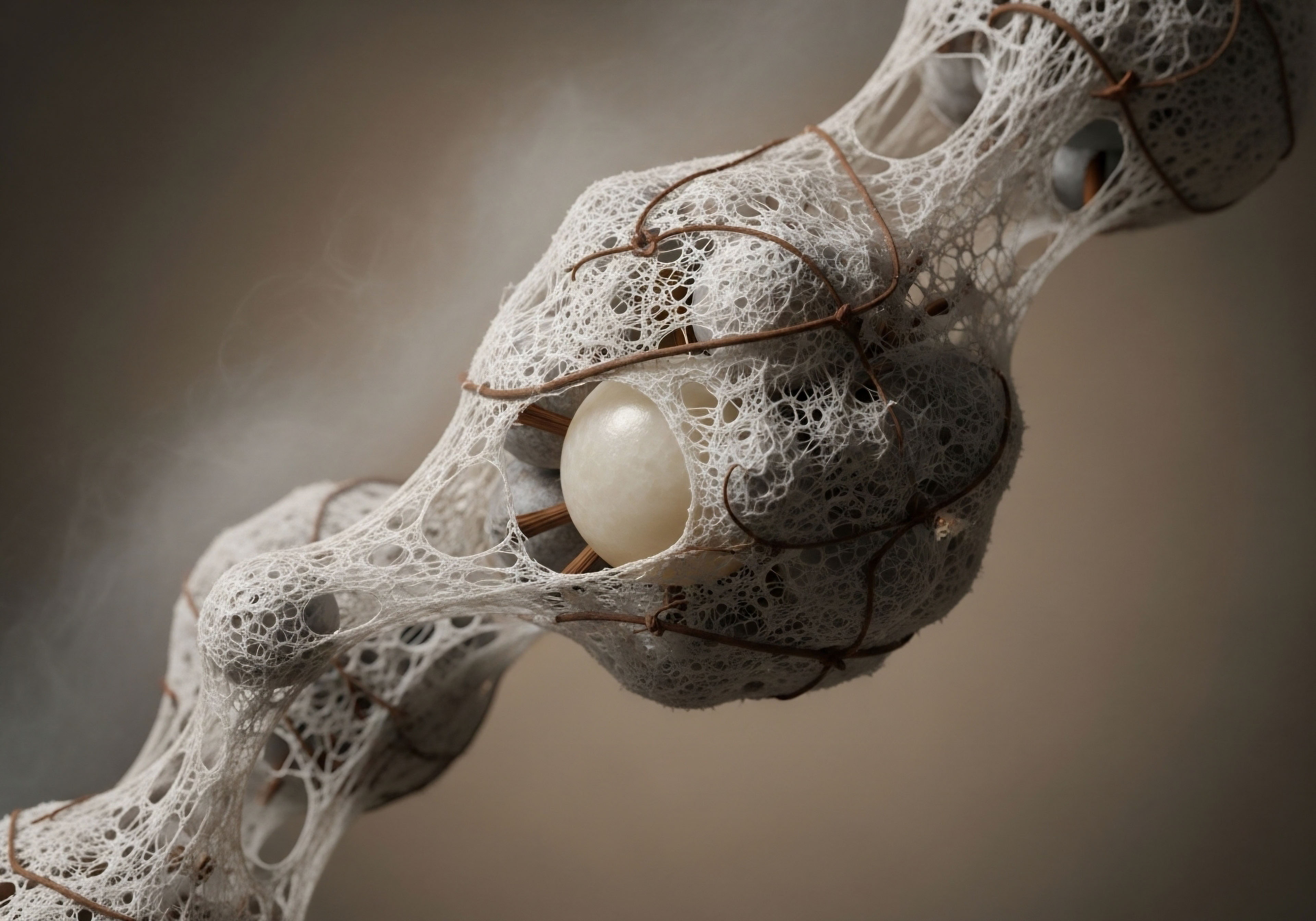

Fundamentals
When considering hormonal health, particularly for men, a common concern surfaces around the impact of external hormonal support on the body’s inherent capacity for reproduction. Many individuals experience a quiet apprehension, a subtle worry about what happens to their biological systems when they introduce something as potent as testosterone replacement therapy.
This feeling often stems from a deep, intuitive understanding that our bodies are intricate, self-regulating systems, and altering one part can have cascading effects. The question of whether the body can truly return to its prior state, especially concerning fertility, is a deeply personal one, touching upon future aspirations and a sense of physiological integrity.
Understanding the journey of recovery for sperm production, known as spermatogenesis, after discontinuing external testosterone requires a look at the body’s central command system for male reproductive function. This system is the Hypothalamic-Pituitary-Gonadal (HPG) axis. It functions much like a sophisticated internal communication network, constantly sending and receiving signals to maintain balance.
The hypothalamus, a region in the brain, initiates this communication by releasing Gonadotropin-Releasing Hormone (GnRH). This chemical messenger travels to the pituitary gland, a small but mighty organ situated at the base of the brain.
Upon receiving GnRH, the pituitary gland responds by secreting two vital hormones ∞ Luteinizing Hormone (LH) and Follicle-Stimulating Hormone (FSH). LH then travels through the bloodstream to the testes, stimulating specialized cells called Leydig cells to produce testosterone. Simultaneously, FSH acts on the Sertoli cells within the testes, which are essential for supporting and nourishing developing sperm cells. This coordinated action of LH and FSH is absolutely necessary for the ongoing process of spermatogenesis.
The body’s reproductive system operates through a delicate feedback loop, where external testosterone can temporarily quiet its natural signaling.
When an individual begins testosterone replacement therapy, a significant shift occurs within this delicate HPG axis. The introduction of external testosterone signals to the brain that there is already an abundance of this hormone in the system. In response, the hypothalamus and pituitary gland reduce their output of GnRH, LH, and FSH.
This suppression is a natural physiological response, a form of negative feedback designed to prevent overproduction of hormones. While beneficial for addressing symptoms of low testosterone, this suppression directly impacts the testes. With reduced LH, Leydig cells produce less natural testosterone, and with diminished FSH, the Sertoli cells receive less stimulation, leading to a significant decrease, or even a complete halt, in sperm production.
The cessation of spermatogenesis during external testosterone administration is a well-documented effect. This is why individuals undergoing testosterone therapy who wish to maintain fertility are often prescribed additional medications, such as Gonadorelin, which acts as a GnRH analogue, or human chorionic gonadotropin (hCG), which mimics LH, to keep the testes active.
Without such interventions, the testes become quiescent, and the machinery of sperm production slows or stops. The prospect of restarting this intricate process after a period of dormancy is what prompts many questions about recovery rates and timelines.

Understanding the Body’s Hormonal Dialogue
The endocrine system engages in a constant dialogue, with hormones acting as messengers carrying instructions throughout the body. When this dialogue is interrupted, as it is with external hormonal administration, the body adapts. The duration and dosage of external testosterone can influence the degree of suppression experienced by the HPG axis. A longer period of therapy or higher doses may lead to a more pronounced and potentially longer-lasting suppression of natural testicular function.
Re-establishing this hormonal dialogue after discontinuing external testosterone involves reactivating the HPG axis. This means encouraging the hypothalamus to resume GnRH secretion, prompting the pituitary to release LH and FSH, and finally, stimulating the testes to restart their production of testosterone and, crucially, sperm.
This is not an instantaneous process; it requires time and, in many cases, targeted medical support to help the body recalibrate its internal systems. The body’s capacity for self-regulation is remarkable, but sometimes it needs a gentle nudge to regain its previous rhythm.


Intermediate
The journey to restoring spermatogenesis after discontinuing external testosterone involves a carefully considered approach, often utilizing specific clinical protocols designed to reactivate the suppressed HPG axis. This process is not a one-size-fits-all solution; it requires a personalized strategy that accounts for individual physiological responses and the duration of prior external testosterone administration. The goal is to gently coax the body’s own hormonal production back online, particularly focusing on the signals necessary for sperm generation.
A primary component of post-therapy recovery protocols is the use of medications that directly or indirectly stimulate the HPG axis. These agents work by either mimicking natural hormones or by blocking negative feedback signals, thereby encouraging the pituitary gland and testes to resume their normal functions. The choice and combination of these agents depend on the specific needs of the individual and the degree of testicular suppression observed.

Targeted Agents for Recovery
Several key pharmaceutical agents are commonly employed in protocols aimed at restoring spermatogenesis. Each plays a distinct role in recalibrating the endocrine system:
- Gonadorelin ∞ This synthetic analogue of GnRH directly stimulates the pituitary gland to release LH and FSH. By providing this upstream signal, Gonadorelin helps to re-establish the pulsatile release of gonadotropins, which is essential for healthy testicular function and sperm production. It acts as a direct command to the pituitary, signaling it to resume its crucial role in the reproductive cascade.
- Tamoxifen ∞ As a selective estrogen receptor modulator (SERM), Tamoxifen works by blocking estrogen’s negative feedback on the hypothalamus and pituitary. When estrogen levels are perceived as high (even if they are not, due to the body’s altered feedback loop from external testosterone), the brain reduces GnRH, LH, and FSH. By blocking estrogen receptors in the brain, Tamoxifen effectively removes this inhibitory signal, prompting an increase in LH and FSH secretion, which in turn stimulates testicular testosterone production and spermatogenesis.
- Clomid (Clomiphene Citrate) ∞ Similar to Tamoxifen, Clomid is also a SERM. It competes with estrogen for binding sites at the hypothalamus and pituitary, thereby preventing estrogen from exerting its inhibitory effect. This leads to an increase in GnRH, LH, and FSH release, providing the necessary hormonal signals to reactivate the testes and promote sperm production. Clomid is often a first-line agent due to its effectiveness in stimulating endogenous gonadotropin release.
- Anastrozole ∞ This medication is an aromatase inhibitor. Aromatase is an enzyme that converts testosterone into estrogen. While some estrogen is necessary, excessive levels can contribute to HPG axis suppression and potentially hinder spermatogenesis recovery. Anastrozole reduces estrogen levels, thereby alleviating a potential inhibitory factor on the HPG axis and supporting a more favorable hormonal environment for testicular function. It is used judiciously, as some estrogen is vital for male health.
These agents are often used in combination, creating a synergistic effect to maximize the chances of recovery. The precise dosages and duration of treatment are highly individualized, guided by regular monitoring of hormonal blood levels, including testosterone, LH, FSH, and estradiol, as well as semen analysis to track sperm count, motility, and morphology.
Restoring sperm production after external testosterone requires a strategic re-engagement of the body’s natural hormonal pathways.

How Does Prior Testosterone Use Influence Recovery?
The length of time an individual has been on external testosterone therapy and the dosage administered can influence the speed and completeness of spermatogenesis recovery. Shorter durations of therapy and lower doses generally correlate with faster and more robust recovery. Prolonged suppression can lead to a more profound testicular atrophy, making the process of reactivation more challenging. However, even after extended periods, many individuals experience significant recovery with appropriate medical intervention.
The recovery process is not linear. It can involve fluctuations in hormonal levels and sperm parameters. Patience and consistent adherence to the prescribed protocol are essential. Semen analysis is typically performed at regular intervals, often every 3-6 months, to monitor progress. The goal is not merely to restore testosterone production but specifically to re-establish viable sperm counts for reproductive purposes.
Consider the endocrine system as a finely tuned orchestra. When external testosterone is introduced, it’s like the conductor telling certain sections of the orchestra to quiet down. The recovery protocol involves the conductor, through specific medications, signaling those sections to play again, gradually bringing the entire ensemble back into harmony.
| Agent | Primary Mechanism of Action | Targeted Effect |
|---|---|---|
| Gonadorelin | GnRH analogue; direct pituitary stimulation | Increases LH and FSH release |
| Tamoxifen | Selective Estrogen Receptor Modulator (SERM) | Blocks estrogen negative feedback on pituitary/hypothalamus, increasing LH/FSH |
| Clomid | Selective Estrogen Receptor Modulator (SERM) | Blocks estrogen negative feedback on pituitary/hypothalamus, increasing LH/FSH |
| Anastrozole | Aromatase Inhibitor | Reduces estrogen conversion from testosterone, potentially reducing HPG axis suppression |

What Factors Influence Spermatogenesis Recovery?
Several variables can impact the long-term recovery rates of spermatogenesis following the cessation of external testosterone. These factors are often interconnected, painting a complex picture of individual physiological responses.
- Duration of External Testosterone Therapy ∞ Generally, shorter periods of external testosterone administration are associated with quicker and more complete recovery of sperm production. Extended periods of suppression can lead to more pronounced testicular atrophy, potentially requiring longer recovery times.
- Dosage of External Testosterone ∞ Higher doses of external testosterone typically result in more significant suppression of the HPG axis, which may prolong the recovery period for spermatogenesis.
- Individual Physiological Variability ∞ Each person’s endocrine system responds uniquely. Genetic predispositions, baseline testicular function, and overall metabolic health can all play a role in how quickly and effectively the HPG axis reactivates.
- Age of the Individual ∞ Younger individuals often exhibit a more robust and rapid recovery of spermatogenesis compared to older individuals, whose natural testicular function may already be in decline.
- Presence of Co-existing Conditions ∞ Underlying health issues, such as obesity, metabolic syndrome, or other endocrine disorders, can influence hormonal balance and potentially impede the recovery process.
- Adherence to Post-Therapy Protocol ∞ Consistent and correct use of prescribed medications like Gonadorelin, Tamoxifen, or Clomid is vital for stimulating the HPG axis and supporting testicular function.
- Nutritional Status and Lifestyle ∞ Adequate nutrition, regular physical activity, stress management, and avoidance of toxins can all contribute to overall hormonal health and support the body’s recovery mechanisms.
Understanding these influencing factors allows for a more realistic expectation of recovery timelines and helps tailor the post-therapy protocol to the individual’s specific circumstances. It is a collaborative effort between the individual and their healthcare provider to optimize the conditions for successful spermatogenesis restoration.


Academic
The deep understanding of spermatogenesis recovery after exogenous testosterone cessation requires a detailed examination of the molecular and cellular events within the testes and the intricate feedback mechanisms of the HPG axis. The process is not merely about restarting hormone production; it involves the re-establishment of a highly organized cellular differentiation pathway within the seminiferous tubules. This complex biological process is governed by precise hormonal concentrations and local paracrine factors.
The suppression induced by external testosterone primarily targets the pituitary gland’s secretion of LH and FSH. Luteinizing Hormone (LH) acts on the Leydig cells, which are interstitial cells located between the seminiferous tubules. These cells are the primary source of endogenous testosterone within the testes.
The local concentration of testosterone, produced by Leydig cells under LH stimulation, is absolutely necessary for the maintenance of spermatogenesis. Without sufficient LH, Leydig cells become quiescent, leading to a significant reduction in intratesticular testosterone (ITT) levels. This localized testosterone is orders of magnitude higher than circulating levels and is critical for the progression of germ cell development.
Follicle-Stimulating Hormone (FSH), on the other hand, primarily targets the Sertoli cells, often referred to as “nurse cells” due to their supportive role in spermatogenesis. Sertoli cells form the blood-testis barrier, create the microenvironment for germ cell development, and produce various factors, including androgen-binding protein (ABP) and inhibin.
ABP helps maintain high local testosterone concentrations within the seminiferous tubules, which is vital for germ cell maturation. Inhibin, produced by Sertoli cells, provides negative feedback to the pituitary, specifically regulating FSH secretion. The absence of adequate FSH stimulation leads to impaired Sertoli cell function, compromising the structural and nutritional support necessary for developing sperm.
The reawakening of sperm production hinges on the precise re-calibration of LH and FSH signaling to testicular cells.

Molecular Mechanisms of Suppression and Recovery
Exogenous testosterone exerts its suppressive effect by binding to androgen receptors in the hypothalamus and pituitary. This binding mimics the presence of high endogenous testosterone, leading to a reduction in GnRH pulsatility from the hypothalamus and decreased sensitivity of the pituitary to GnRH. The consequence is a profound decrease in LH and FSH secretion.
This hormonal deprivation directly impacts the testes, leading to a reduction in Leydig cell activity and Sertoli cell function, culminating in impaired spermatogenesis. The seminiferous tubules, where sperm are produced, can undergo atrophy, and the germ cell population can significantly diminish.
Recovery protocols aim to reverse this suppression. Medications like Clomiphene Citrate and Tamoxifen, as SERMs, block estrogen receptors in the hypothalamus and pituitary. This action effectively removes the negative feedback signal that estrogen exerts on GnRH, LH, and FSH release.
The resulting increase in gonadotropin secretion then stimulates the Leydig cells to produce testosterone and the Sertoli cells to resume their supportive functions, thereby reactivating spermatogenesis. Gonadorelin directly provides the GnRH signal, bypassing hypothalamic suppression and directly stimulating pituitary gonadotropin release.
The timeline for spermatogenesis recovery is highly variable, ranging from several months to over a year. Studies indicate that while serum testosterone levels may normalize relatively quickly, the restoration of sperm parameters (count, motility, morphology) often lags.
This is because spermatogenesis itself is a lengthy process, taking approximately 74 days for a germ cell to develop into a mature spermatozoon, plus additional time for epididymal maturation. Therefore, even after hormonal signals are restored, it takes time for new sperm to be produced and become viable.

Clinical Data and Recovery Timelines
Clinical research provides valuable insights into the long-term recovery rates. While complete recovery of baseline sperm parameters is common, the exact rates and timelines vary widely across studies, influenced by patient demographics, duration of external testosterone use, and the specific recovery protocol employed.
Many studies report successful recovery of sperm production in a significant majority of men within 6 to 12 months following cessation of external testosterone and initiation of a recovery protocol. Some individuals may require longer periods, extending up to 18-24 months.
A key metric for successful recovery is the achievement of sperm concentrations sufficient for natural conception or assisted reproductive technologies. While some men may not return to their exact pre-therapy sperm counts, many achieve counts within the fertile range. The integrity of the testicular tissue and the duration of germ cell aplasia during suppression are critical determinants of the ultimate recovery potential.
| Recovery Metric | Typical Timeframe Post-Cessation | Observed Success Rate (Approximate) |
|---|---|---|
| Serum Testosterone Normalization | 3-6 months | High (over 90%) |
| Sperm Count Restoration (>15 million/mL) | 6-12 months | Moderate to High (70-90%) |
| Motility and Morphology Improvement | 9-18 months | Variable, often lags count recovery |
| Conception Potential Re-establishment | 6-24 months | Dependent on individual and partner factors |

How Does Testicular Atrophy Impact Recovery?
Prolonged suppression of the HPG axis by external testosterone can lead to a reduction in testicular volume, a condition known as testicular atrophy. This atrophy reflects a decrease in the cellular mass of the testes, particularly the seminiferous tubules, which are the sites of spermatogenesis. The degree of atrophy can correlate with the duration and dosage of external testosterone therapy. While testicular atrophy is often reversible, severe or long-standing atrophy may present a greater challenge for complete spermatogenesis recovery.
The recovery of testicular volume and function relies on the re-stimulation of Leydig and Sertoli cells. As LH and FSH levels rise in response to recovery protocols, these cells are reactivated, leading to an increase in local testosterone production and renewed support for germ cell development.
The capacity of the germline stem cells to re-initiate proliferation and differentiation after a period of quiescence is a testament to the body’s regenerative potential. However, in some rare cases of very prolonged and profound suppression, the damage to the seminiferous epithelium might be more resistant to full recovery.
The interplay between systemic hormonal signals and local testicular factors is a complex dance. The success of recovery protocols lies in their ability to re-establish this delicate balance, providing the necessary hormonal cues while supporting the cellular environment within the testes. Ongoing research continues to refine these protocols, aiming to optimize recovery rates and minimize the time to restored fertility for individuals who have chosen to discontinue external testosterone.

What Are the Long-Term Implications for Reproductive Health?
The long-term implications for reproductive health following testosterone cessation and spermatogenesis recovery are a subject of ongoing clinical observation. For most individuals, with appropriate medical guidance and adherence to recovery protocols, the ability to conceive is restored. However, it is important to acknowledge that individual responses can vary.
Some men may experience a permanent reduction in baseline sperm parameters, even if they achieve counts within the fertile range. The overall health of the reproductive system, including the epididymis and accessory glands, also plays a role in the quality and viability of sperm.
The decision to discontinue external testosterone for fertility purposes is a significant one, often requiring careful consideration of personal goals and potential timelines. A comprehensive assessment by an endocrinologist or reproductive specialist is essential to develop a tailored recovery plan and to monitor progress effectively.
This includes not only hormonal blood tests but also serial semen analyses to track the return of viable sperm. The journey back to full reproductive capacity is a testament to the body’s resilience, guided by precise clinical interventions.

References
- Bhasin, S. et al. “Testosterone Therapy in Men With Hypogonadism ∞ An Endocrine Society Clinical Practice Guideline.” Journal of Clinical Endocrinology & Metabolism, vol. 103, no. 5, 2018, pp. 1715-1744.
- Khera, M. et al. “A Systematic Review of the Effects of Testosterone Replacement Therapy on Spermatogenesis in Hypogonadal Men.” Journal of Sexual Medicine, vol. 16, no. 11, 2019, pp. 1721-1730.
- Shabsigh, R. et al. “Clomiphene Citrate and Gonadotropin-Releasing Hormone Agonists for the Management of Hypogonadism and Infertility in Men.” Urology, vol. 76, no. 6, 2010, pp. 1422-1426.
- Paduch, D. A. et al. “Testosterone Replacement Therapy and Male Infertility ∞ A Systematic Review.” Fertility and Sterility, vol. 105, no. 6, 2016, pp. 1594-1601.
- Ramirez, N. D. et al. “Recovery of Spermatogenesis After Cessation of Exogenous Testosterone in Men.” Translational Andrology and Urology, vol. 9, no. 3, 2020, pp. 1451-1459.
- Weinbauer, G. F. and Nieschlag, E. “Gonadotropin-Releasing Hormone Agonists and Antagonists in Male Contraception.” Frontiers in Endocrinology, vol. 10, 2019, p. 745.
- Boron, W. F. and Boulpaep, E. L. Medical Physiology. 3rd ed. Elsevier, 2017.
- Guyton, A. C. and Hall, J. E. Textbook of Medical Physiology. 13th ed. Elsevier, 2016.

Reflection
Understanding the intricate dance of your own biological systems, particularly after navigating hormonal interventions, can be a truly empowering experience. The information presented here regarding spermatogenesis recovery is not merely a collection of facts; it represents a deeper insight into the body’s remarkable capacity for adaptation and restoration. Your personal health journey is unique, shaped by your individual physiology, lifestyle, and aspirations.
This knowledge serves as a foundation, a starting point for a more informed dialogue with your healthcare provider. It invites you to consider how your body functions at a fundamental level, moving beyond surface-level symptoms to appreciate the underlying mechanisms.
The path to reclaiming vitality and function is often a collaborative one, requiring both scientific understanding and a compassionate approach to your lived experience. Consider this exploration a step towards becoming a more active participant in your own well-being, guiding your choices with clarity and confidence.



